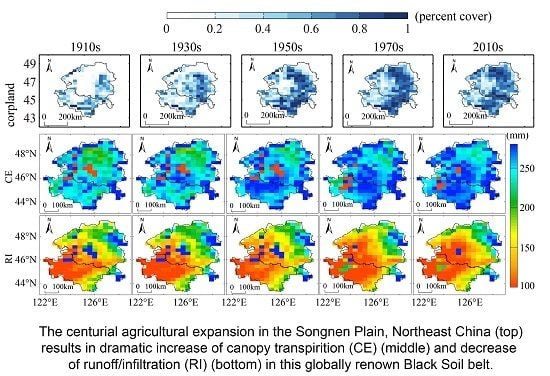Impacts of Agricultural Expansion (1910s–2010s) on the Water Cycle in the Songneng Plain, Northeast China
Abstract
1. Introduction
2. Materials and Methodology
2.1. Study Region
2.2. Data Sets
2.3. Approaches
TET = CE + IE + LE
3. Results and Discussion
3.1. The Centurial LULC Change (1910s–2010s)
3.2. The WRF-Simulated Water Effects
3.2.1. WRF Model Validation
3.2.2. Water Effects of Agricultural Expansion
3.3. Comparison with Drought Index
4. Conclusions
- (1)
- Agricultural lands in the plain were primarily converted from the historically predominant grasslands and were expanded from 28% of the plain in the 1910s to 72% in the 2010s.
- (2)
- The WRF model simulations showed that the plain-wide precipitation did not change significantly in the past 100 years but agricultural expansion resulted in a dramatic increase in canopy transpiration (at an average rate of 36 mm/10a) and vegetation interception evaporation (6 mm/10a) and a decrease in surface runoff and infiltration in soil (−44 mm/10a) and land surface evaporation (−8 mm/10a). All these aspects jointly attributed to the increased evapotranspirition across the plain.
- (3)
- This study reveals a drought effect of centurial agricultural expansion in the Songnen Plain, which is supported by the stronger decreasing trends of the Palmer Index since the 1980s. The drying trend in its Black Soil raises alarm about the sustainability of this famous Black Soil Belt.
Author Contributions
Funding
Conflicts of Interest
References
- Pielke, R.A. Land use and climate change. Science 2005, 310, 1625–1626. [Google Scholar] [CrossRef] [PubMed]
- Sterling, S.M.; Ducharne, A.; Polcher, J. The impact of global land-cover change on the terrestrial water cycle. Nat. Clim. Chang. 2012, 3, 13688–13692. [Google Scholar] [CrossRef]
- Feddema, J.J.; Oleson, K.W.; Bonan, G.B.; Mearns, L.O.; Buja, L.E.; Meehl, G.A.; Washington, W.M. The importance of land-cover change in simulating future climate. Science 2005, 310, 1674–1678. [Google Scholar] [CrossRef] [PubMed]
- Stone, B. Land use as climate change mitigation. Environ. Sci. Technol. 2009, 43, 9052–9056. [Google Scholar] [CrossRef] [PubMed]
- Foley, J.A.; DeFries, R.; Asner, G.P.; Barford, C.; Bonan, G.; Carpenter, S.R.; Chapin, F.S.; Coe, M.T.; Daily, G.C.; Gibbs, H.K.; et al. Global consequences of land use. Science 2005, 309, 570–574. [Google Scholar] [CrossRef] [PubMed]
- Alexandratos, N.; Bruinsma, J. World Agriculture Towards 2030/2050: The 2012 Revision; ESA Working Paper No. 12–03; FAO: Italy, Rome, 2012. [Google Scholar]
- Owen, O.S.; Chiras, D.D. Natural Resource Conservation: An Ecological Approach; MacMillan Publishing Company: New York, NY, USA, 1990. [Google Scholar]
- Xie, L. The spatial distribution of reclaimed and abandoned land in Luopu of Hotan River Basin in the period of republic of China based on the historical data. Acta Geogr. Sin. 2013, 8, 232–244. (In Chinese) [Google Scholar]
- Xie, L. The development of oasis agriculture and the changes of the ecological environment in Ancient Kroraina. Chin. Agric. Hist. 2001, 20, 16–26. (In Chinese) [Google Scholar]
- Liu, J.Y.; Zhang, Z.X.; Xu, X.L.; Kuang, W.H.; Zho, W.C.; Zhang, S.W.; Li, R.D.; Yan, C.Z.; Yu, D.S.; Wu, S.X.; et al. Spatial patterns and driving forces of land use change in China in the early 21st century. Acta Geogr. Sin. 2009, 64, 1411–1420. [Google Scholar] [CrossRef]
- Sampaio, G.; Nobre, C.A.; Costa, M.H.; Satyamurty, P.; Soares-Filho, B.S.; Cardoso, M. Regional climate change over eastern Amazonia caused by pasture and soybean cropland expansion. Geophys. Res. Lett. 2007, 34, L17709. [Google Scholar] [CrossRef]
- Betts, R.A.; Fallon, P.D.; Goldewijk, K.K.; Ramankutty, N. Biogeophysical effects of land use on climate: Model simulations of radiative forcing and large-scale temperature change. Agric. For. Meteorol. 2007, 142, 216–233. [Google Scholar] [CrossRef]
- Zhang, X.Z.; Liu, J.Y.; Xiong, Z.; Zhang, H.W. Simulated effects of agricultural development on surface air temperature over Central and Eastern China in the late 20th century. Acta Geogr. Sin. 2015, 70, 1423–1433. [Google Scholar]
- Skamarock, W.C.; Klemp, J.B.; Dudhia, J.; Gill, D.O.; Barker, D.M.; Duda, M.G.; Huang, X.Y.; Wang, W.; Powers, J.G. A Description of the Advanced Research WRF Version 3; NCAR Technical Note NCAR/TN-475+STR; National Center for Atmospheric Research: Boulder, CO, USA, 2008. [Google Scholar] [CrossRef]
- Ruiz, J.J.; Saulo, C.; Nogués-Paegle, J. WRF model sensitivity to choice of parameterization over South America: Validation against surface variables. Mon. Weather Rev. 2010, 138, 3342–3355. [Google Scholar] [CrossRef]
- Hong, S.; Lakshmi, V.; Small, E.E.; Chen, F.; Tewari, M.; Manning, K.W. Effects of vegetation and soil moisture on the simulated land surface processes from the coupled WRF/Noah model. J. Geophys. Res. 2009, 114, D18118. [Google Scholar] [CrossRef]
- Cao, Q.; Yu, D.; Georgescu, M.; Han, Z.; Wu, J. Impacts of land use and land cover change on regional climate: A case study in the agro-pastoral transitional zone of China. Environ. Res. Lett. 2015, 10, 124025. [Google Scholar] [CrossRef]
- Oliver, T.H.; Morecroft, M.D. Interactions between climate change and land use change on biodiversity: Attribution problems, risks and opportunities. WIRES Clim. Chang. 2014, 5, 317–335. [Google Scholar] [CrossRef]
- Yu, Y.; Fang, X.Q.; Ren, Y.Y.; Zhang, X.Z.; Chen, L. The cultivated land cover has changed in the last 300 years in the northeast. Sci. China 2009, 39, 340–350. [Google Scholar]
- Sun, J.; Twine, T.E.; Hill, J.; Noe, R.; Shi, J.; Li, M. Effects of land use change for crops on water and carbon budgets in the Midwest USA. Sustainability 2017, 9, 225. [Google Scholar] [CrossRef]
- SooHoo, W.M.; Wang, C.; Li, H. Geospatial assessment of bioenergy land use and its impacts on soil erosion in the U.S. Midwest. J. Environ. Manag. 2017, 190, 188–196. [Google Scholar] [CrossRef] [PubMed]
- Li, F.P.; Zhang, G.X.; Xu, Y.J. Separating the impacts of climate variation and human activities on Runoff in the Songhua River Basin, Northeast China. Water 2014, 6, 3320–3338. [Google Scholar] [CrossRef]
- Zhang, L.J.; Jiang, L.Q.; Zhang, X.Z. Spatial explicit reconstruction of cropland for Heilongjiang province of Northeast China in 1900–1910. J. Geogr. Sci. 2015, 25, 292–602. [Google Scholar] [CrossRef]
- Zhang, L.J.; Jiang, L.Q.; Zhang, X.Z. Reconstruction of cropland spatial pattern and its spatiotemporal changes over the 20th century on the Songnen Plain, Northeast China. J. Geogr. Sci. 2017, 27, 771–785. [Google Scholar] [CrossRef]
- Sun, J.Z. The Regional Economic Geography Science in Northeast China; Science Press: Beijing, China, 1959. (In Chinese) [Google Scholar]
- Hu, X.; Nielsen-Gammon, J.W.; Zhang, F. Evaluation of three planetary boundary layer schemes in the WRF model. J. Appl. Meteorol. Climatol. 2010, 49, 1831–1844. [Google Scholar] [CrossRef]
- Collins, S.N.; James, R.S.; Ray, P.; Chen, K.; Lassman, A.; Brownlee, J. Grids in numerical weather and climate models. In Climate Change and Regional/local Responses; Ray, P., Zhang, Y., Eds.; IntechOpen: London, UK, 2003; pp. 112–128. [Google Scholar]
- Sharma, A.; Fernando, H.J.S.; Hamlet, A.F.; Hellmann, J.J.; Barlage, M.; Chen, F. Urban meteorological modeling using WRF: A sensitivity study. Int. J. Clim. 2017, 37, 1885–1900. [Google Scholar] [CrossRef]
- Niu, G.Y.; Yang, Z.L.; Mitchell, K.E.; Ek, M.B.; Barlage, M.; Kumar, A.; Manning, K.; Niyogi, D.; Rosero, E.; Tewari, M.; et al. The community Noah land surface model with multiparameterization options (Noah-MP): 1. Model description and evaluation with local-scale measurements. J. Geophys. Res. 2011, 116, D12109. [Google Scholar] [CrossRef]
- Palmer, W.C. Meteorological Drought; U.S. Department of Commerce: Washington, DC, USA, 1965; Volume 30. [Google Scholar]
- Guttman, N.B. Comparing the Palmer Drought Index and the standardized precipitation index. J. Am. Water Resour. Assoc. 1998, 34, 113–121. [Google Scholar] [CrossRef]
- Brandt, L.; Rawski, T.G. (Eds.) China’s Great Economic Transformation; Cambridge University Press: Cambridge, UK, 2008. [Google Scholar]
- Liu, Y.B.; Ju, W.M.; Zhu, G.L.; Chen, J.M.; Xing, B.L.; Zhu, J.F.; Zhou, Y.L. Retrieval of leaf area index for different grasslands in Inner Mongolia prairie using remote sensing data. Acta Ecol. Sin. 2011, 31, 5159–5170. [Google Scholar]
- Guttman, N.B. Accepting the Standardized Precipitation Index: A calculation algorithm. J. Am. Water Resour. Assoc. 1999, 35, 311–322. [Google Scholar] [CrossRef]
- Vicente-Serrano, S.M.; Begueria, S.; Lopez-Moreno, J.I. A Multiscalar Drought Index Sensitive to Global Warming: The Standardized Precipitation Evapotranspiration Index. J. Clim. 2010, 23, 1696–1718. [Google Scholar] [CrossRef]
- Zheng, S.; Qin, Z.; Zhang, W. Drought variation in Songnen Plain and its response to climate change. Chin. J. Agrometeorol. 2015, 36, 640–649. (In Chinese) [Google Scholar]
- Zeng, L.; Song, K.; Zhang, B.; Wang, Z. The growing-season drought characteristics in the Songnen Plain since the 1960s. J. Arid Land Resour. Environ. 2010, 24, 114–122. (In Chinese) [Google Scholar]
- Luan, Z.; Zhang, G.; Deng, W. Variations of precipitation and temperature of the Songnen Plain in the past 50 years. Chin. J. Agrometeorol. 2007, 28, 355–358. (In Chinese) [Google Scholar]
- Douglas, E.M.; Niyogi, D.; Frolking, S.; Yeluripati, J.B.; Pielke Sr., R.A.; Niyoigi, N.; Vörösmarty, C.J.; Mohanty, U.C. Changes in moisture and energy fluxes due to agricultural land use and irrigation in the Indian Monsoon Belt. J. Geophys. Res. 2006, 33, L14403. [Google Scholar] [CrossRef]
- Li, X.; Zhang, X.; Zhang, L.; Deng, J. Uncertainty analysis of land use and land cover change to summer precipitation in eastern China. Geogr. Res. 2017, 36, 1233–1244. (In Chinese) [Google Scholar]
- Wu, Y.; Zhang, B.; Song, K.; Liu, H.; Wang, Z.; Liu, D. Retrieval of soil organic matter content from hyper-spectra in Songnen Plain. J. Grad. Sch. Chin. Acad. Sci. 2011, 28, 187–194. (In Chinese) [Google Scholar]
- Bai, R. The climate change and blackland degeneration in SongNen River area. Heilongjiang Meteorol. 2005, 3, 27. (In Chinese) [Google Scholar]
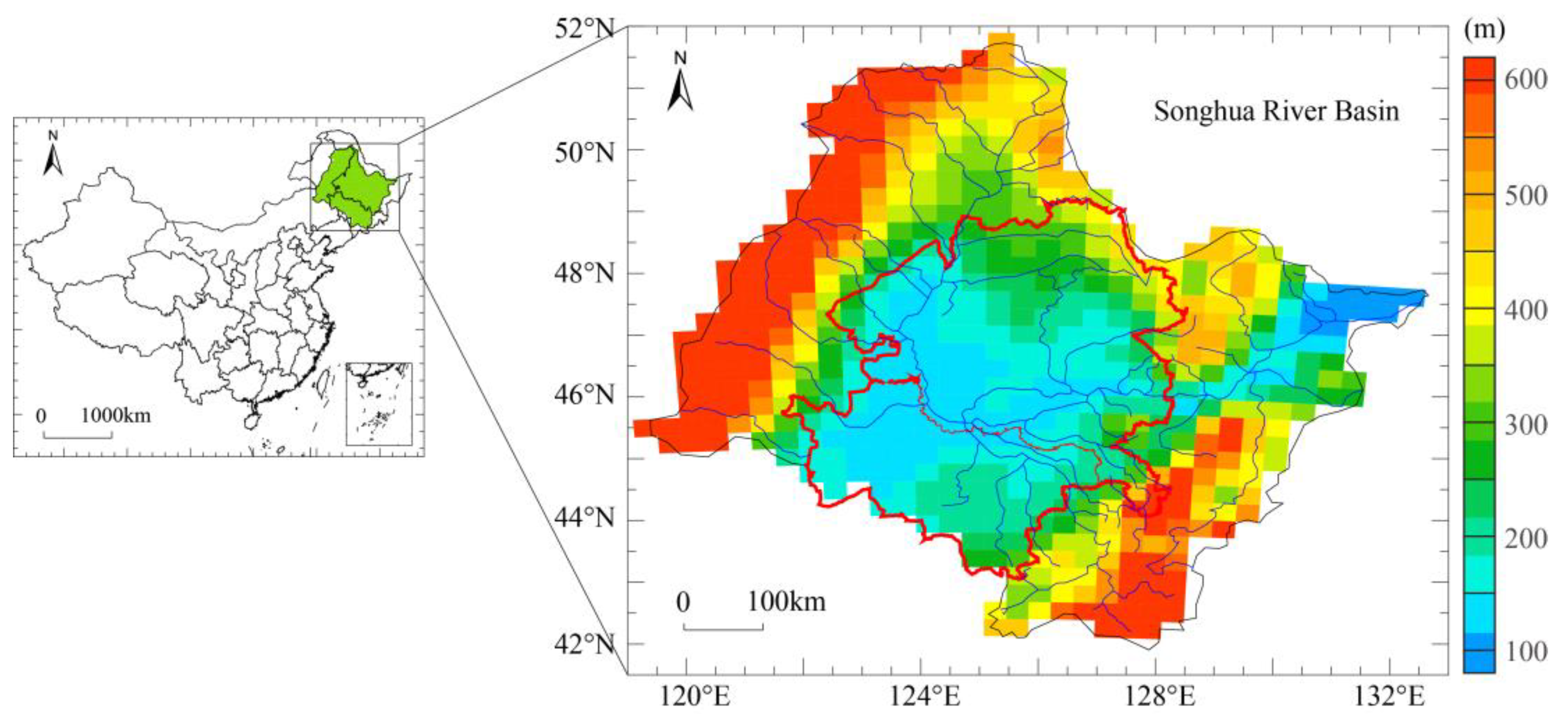
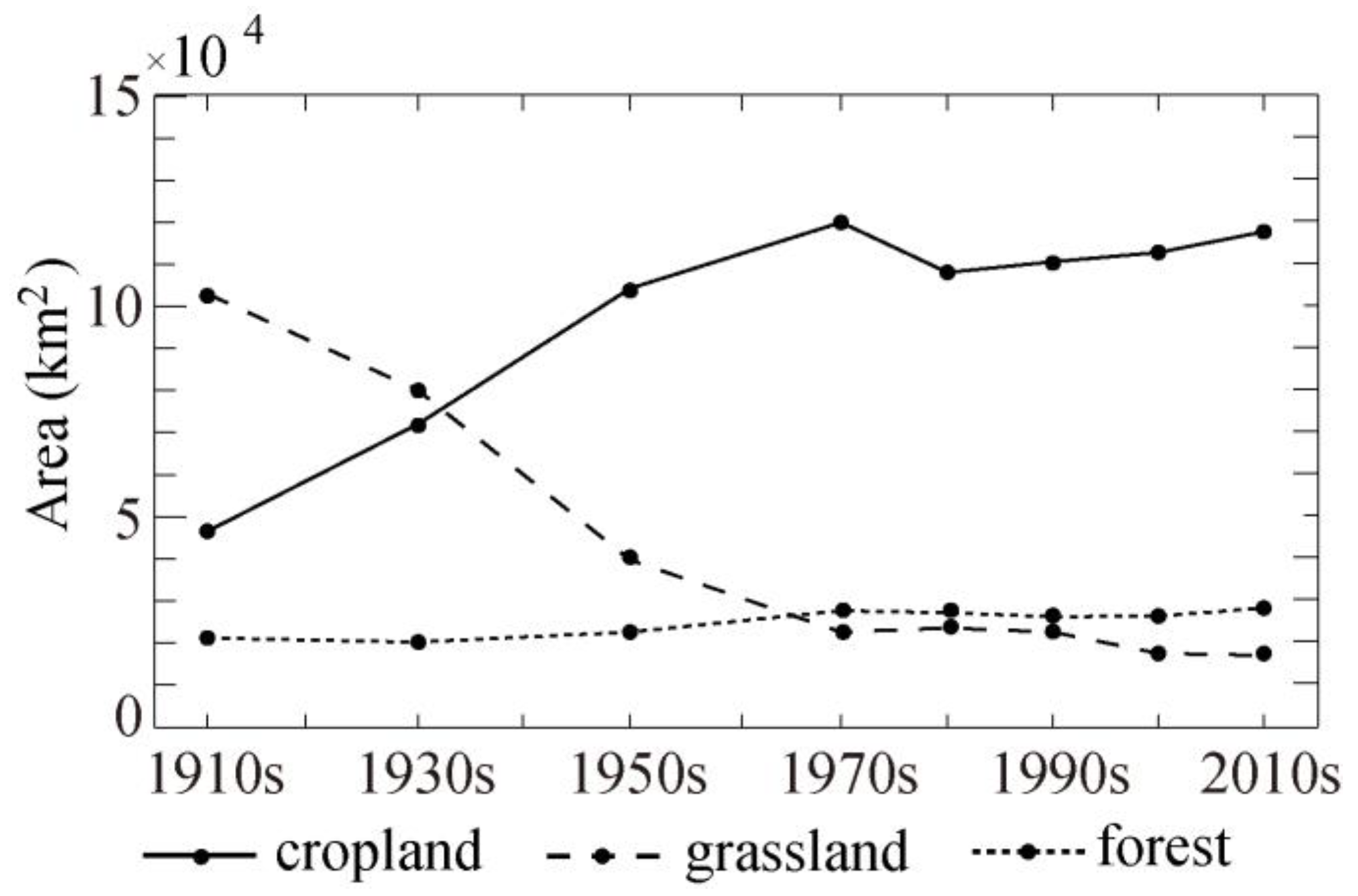
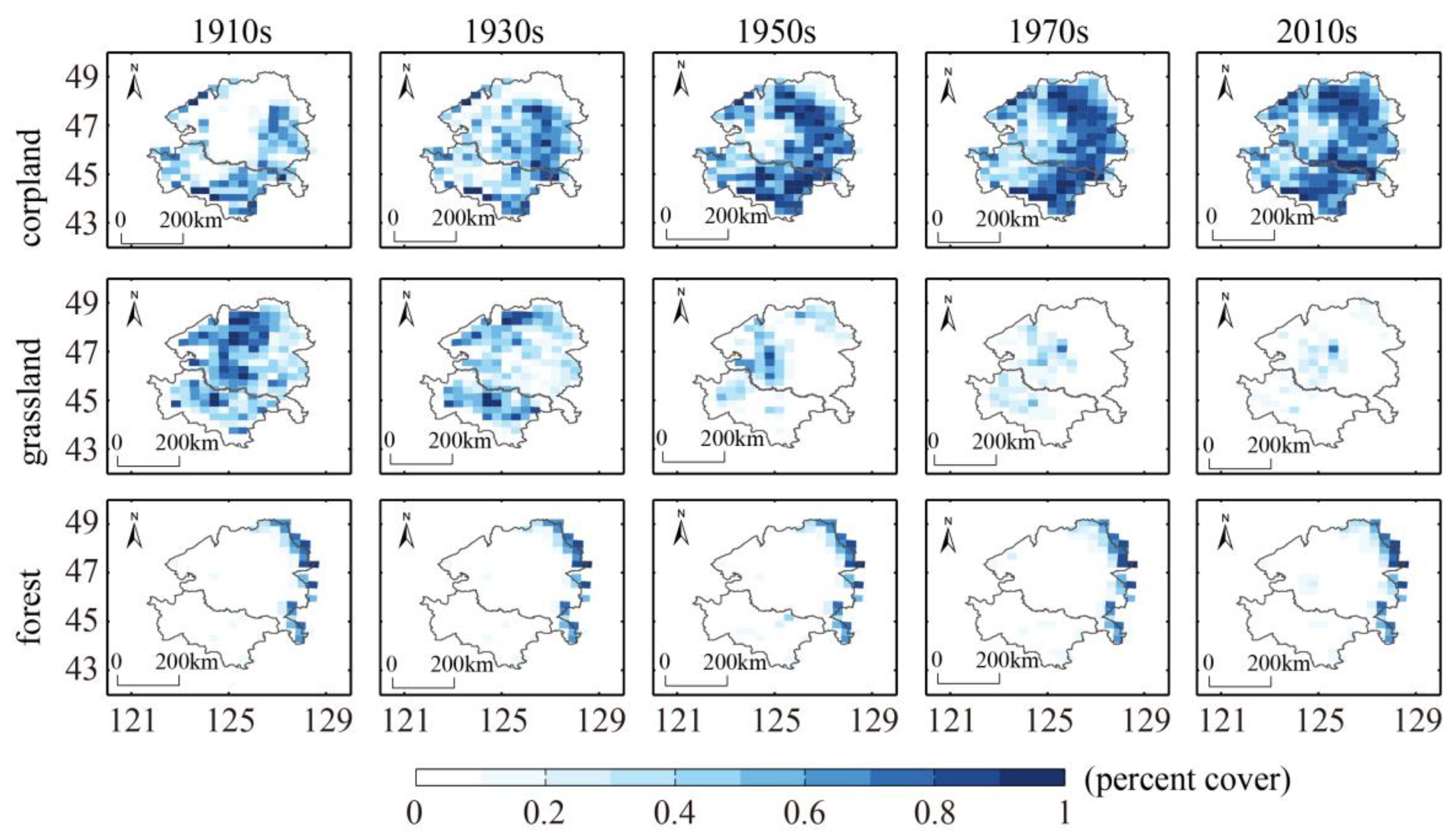
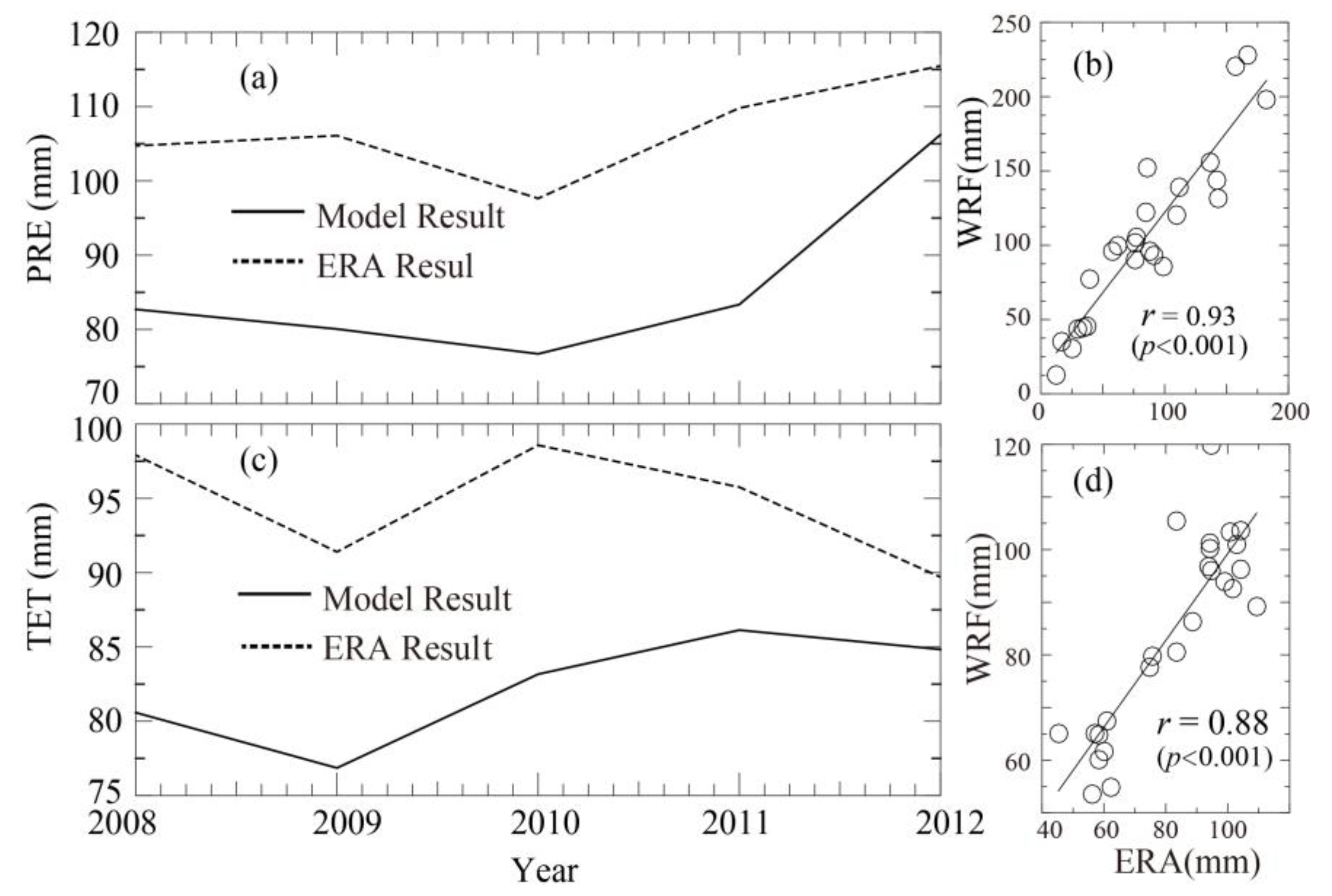
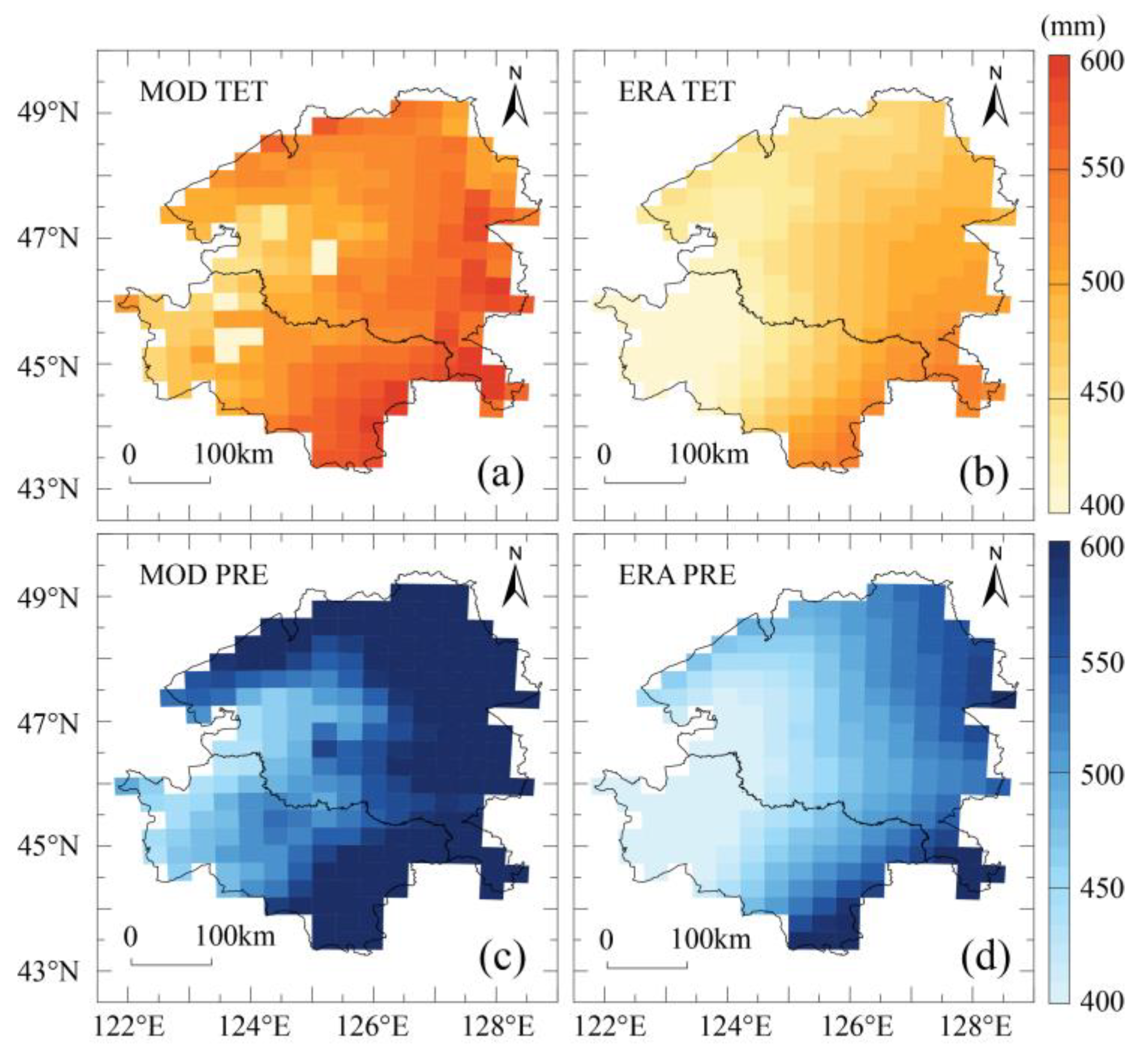
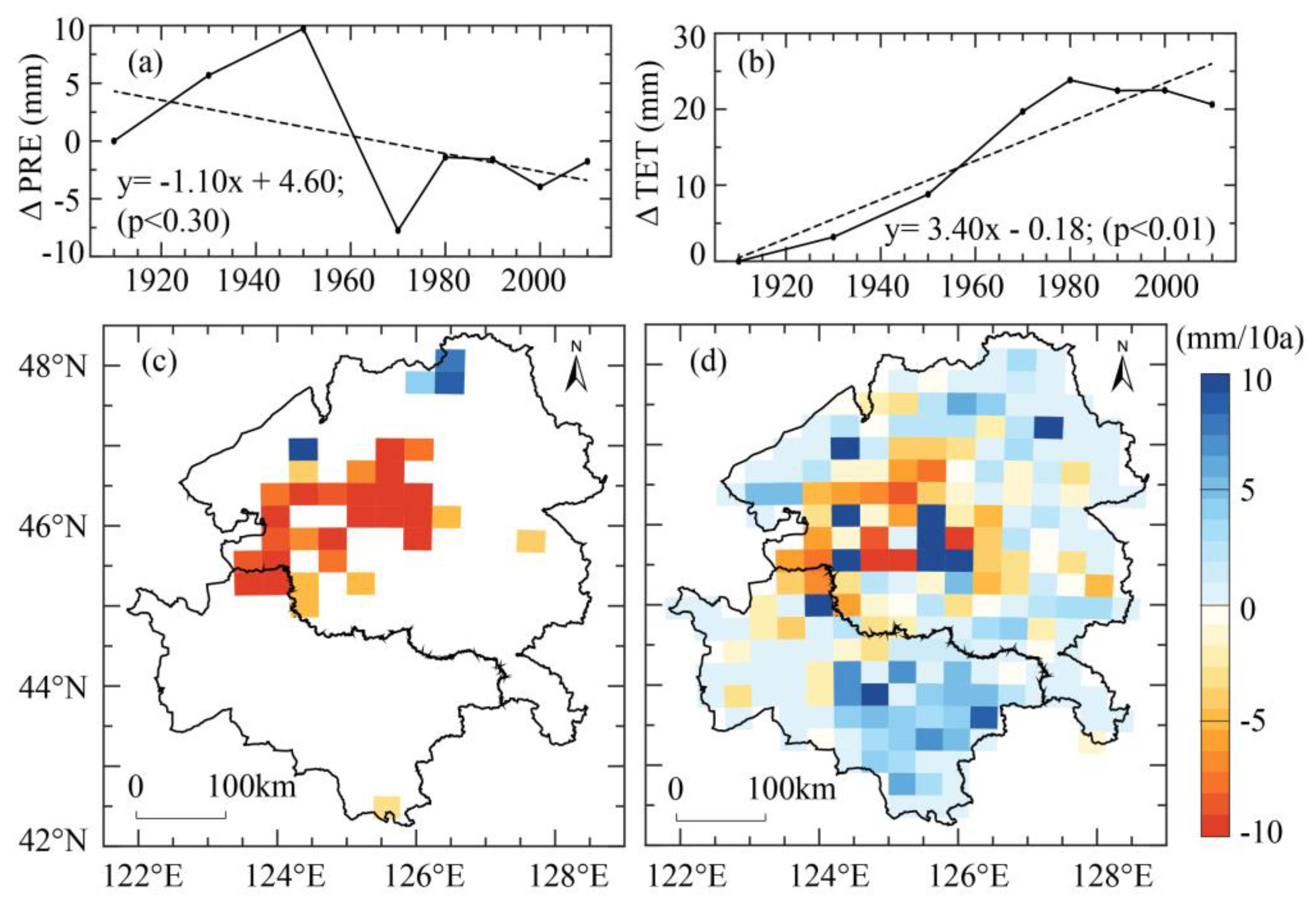
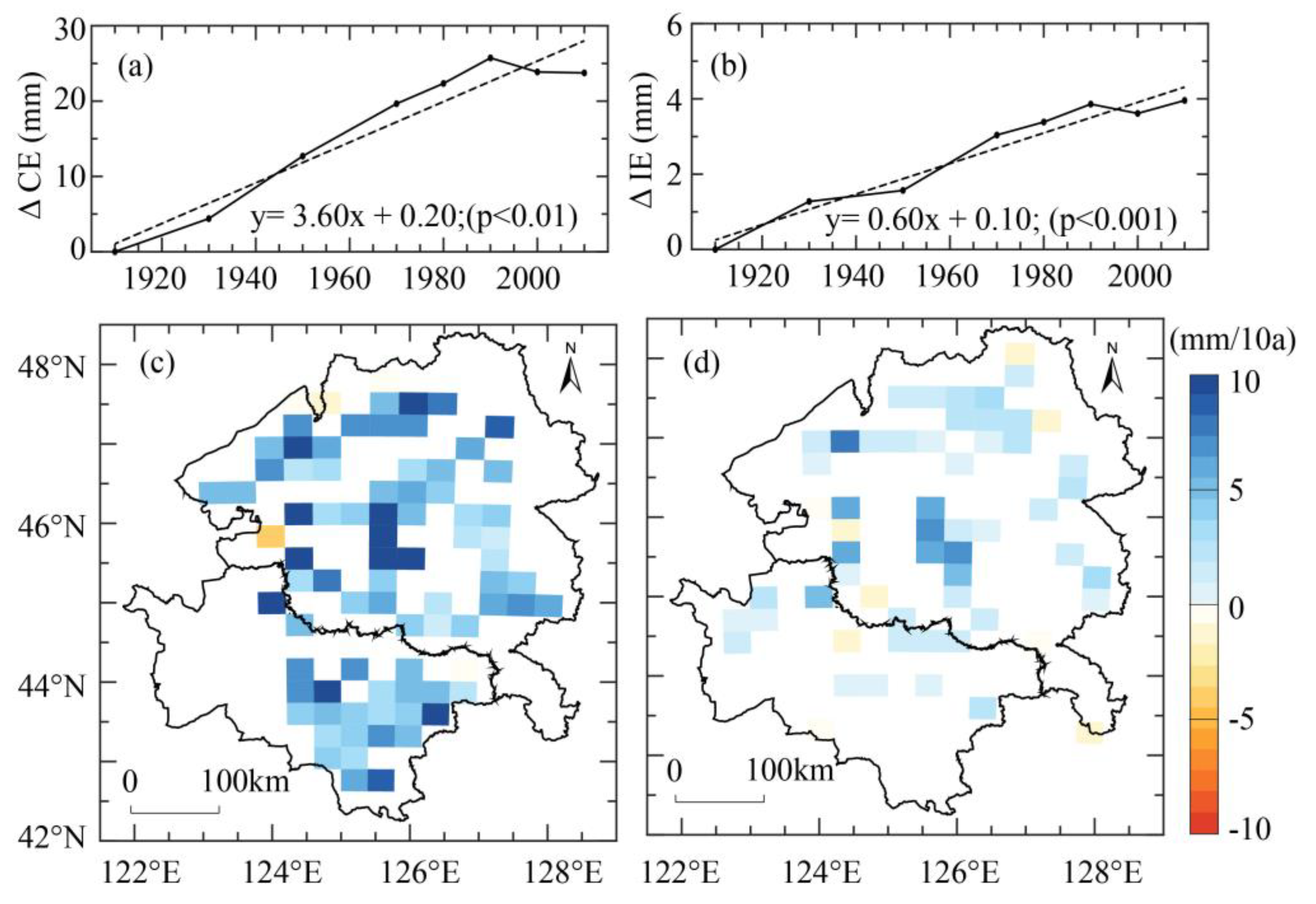
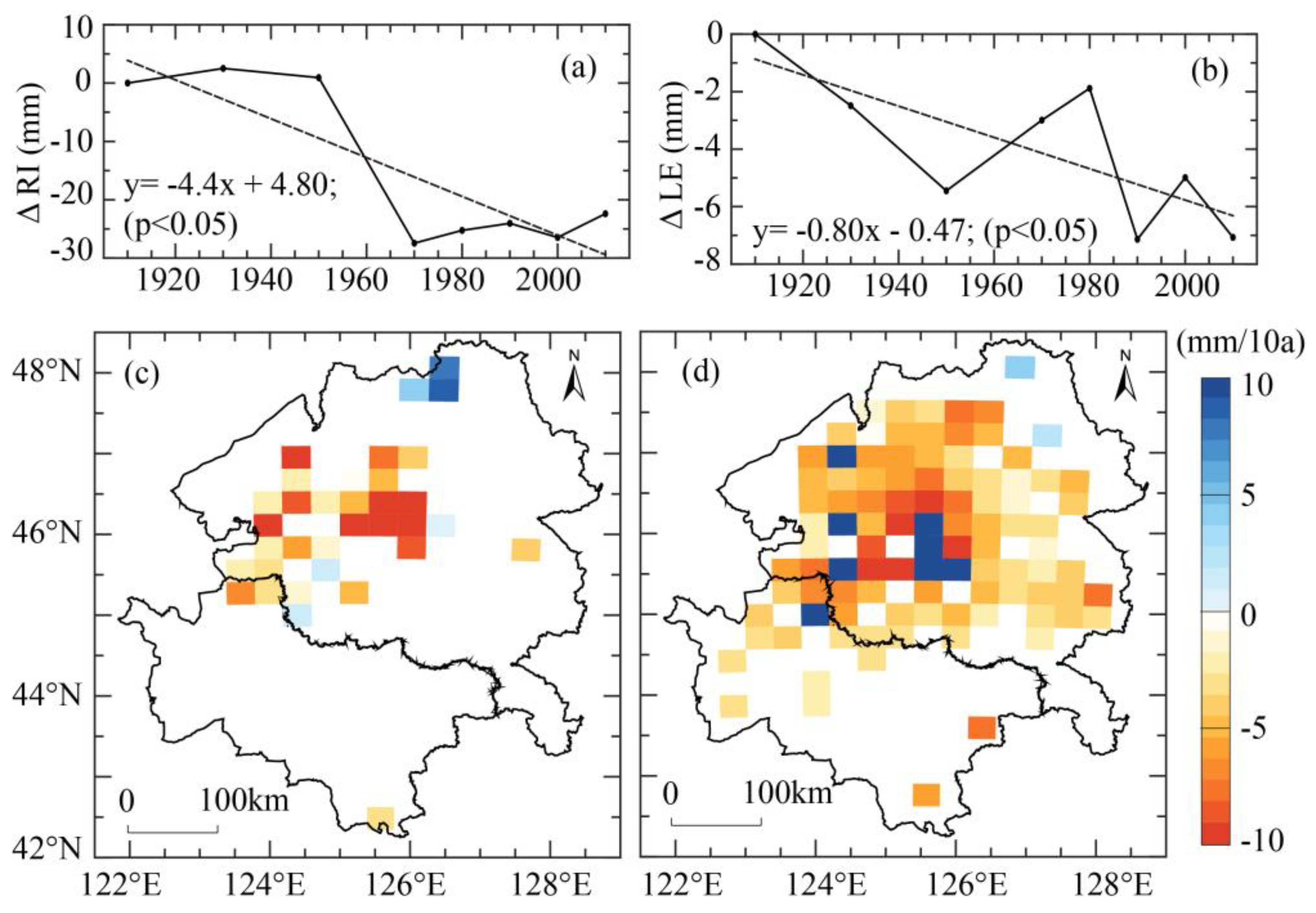
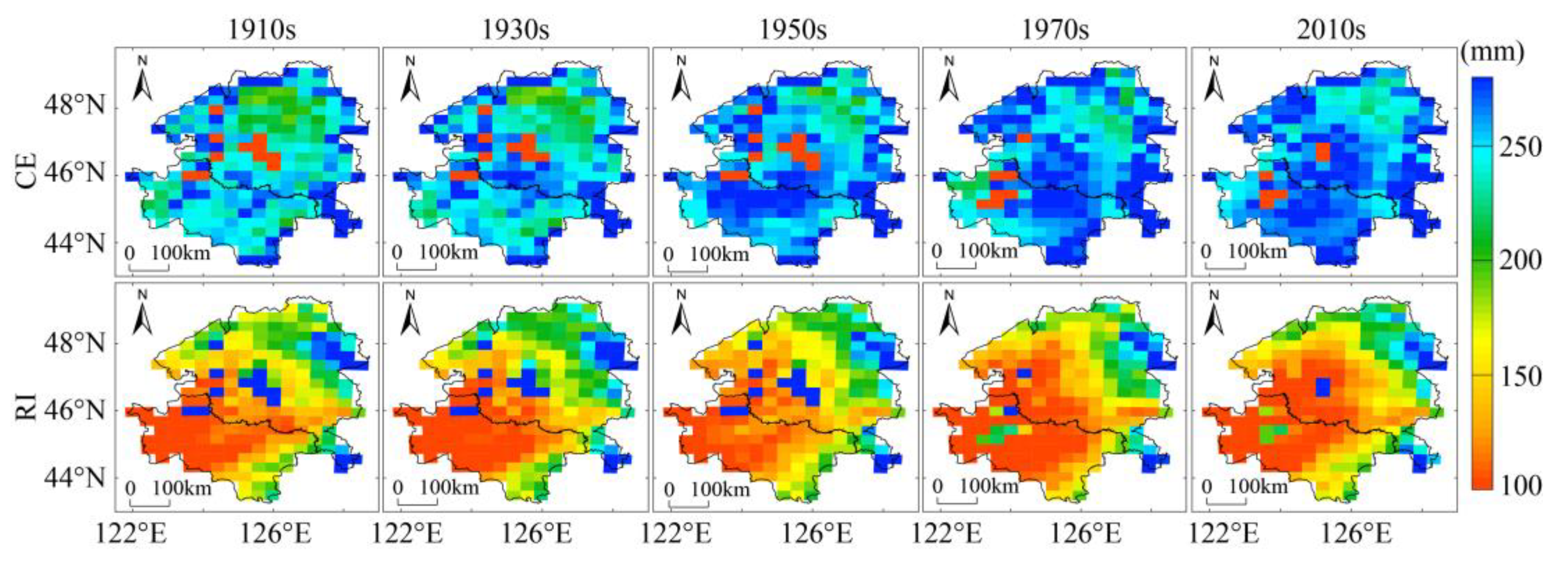
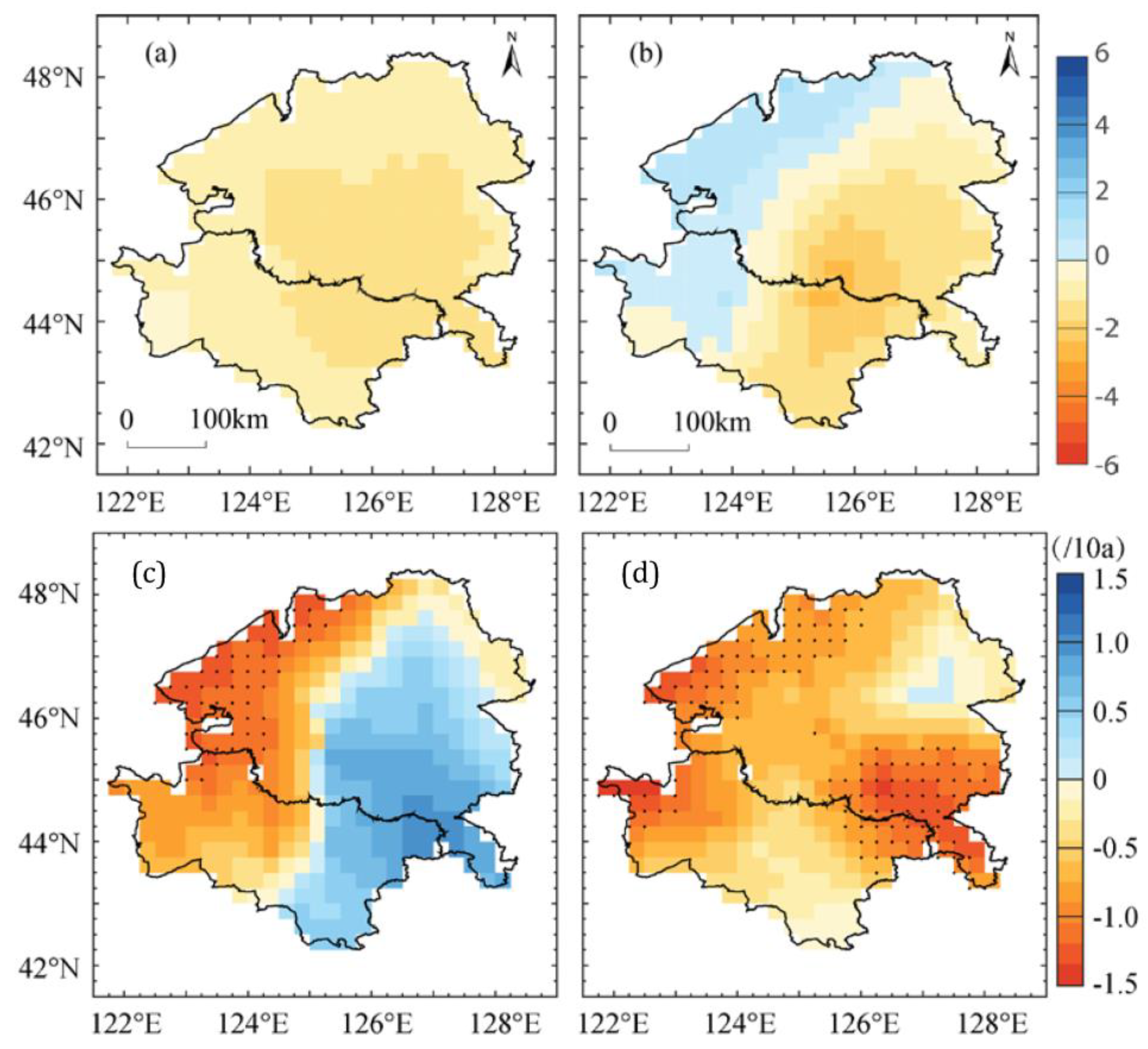
| 1900s | Cropland | Forest | Grassland | Water | Wetland | |
|---|---|---|---|---|---|---|
| 2010s | ||||||
| Cropland | 34,827.73 | 25,469.41 | 62,876.58 | 988.54 | 6951.86 | |
| Forest | 1589.51 | 18,332.04 | 6271.71 | 179.38 | 1431.92 | |
| Grassland | 2368.49 | 3620.72 | 15,184.79 | 807.71 | 3516.76 | |
| Water | 803.99 | 746.14 | 2298.71 | 2963.71 | 2409.82 | |
| Wetland | 0.36 | 0.32 | 0.69 | 0.28 | 5718.10 | |
| Developed land | 0.185 | 0.122 | 0.225 | 0.07 | 0.06 | |
| Climatic Variables | 1901~1930 | 1981~2010 | Variance Analysis (t Value) | |||
|---|---|---|---|---|---|---|
| Annual | Growing-Season | Annual | Growing-Season | Annual | Growing-Season | |
| Precipitation (mm) | 495.133 | 426.315 | 516.636 | 442.125 | −1.047 | −0.867 |
| evaporation (mm) | 791.055 | 566.148 | 821.472 | 574.073 | −3.046 ** | −1.037 |
| precipitation days (d) | 84.122 | 56.059 | 85.267 | 56.166 | −0.811 | −0.095 |
| Water vapor pressure (hpa) | 7.483 | 14.310 | 7.783 | 14.671 | −4.152 ** | −2.432 * |
© 2018 by the authors. Licensee MDPI, Basel, Switzerland. This article is an open access article distributed under the terms and conditions of the Creative Commons Attribution (CC BY) license (http://creativecommons.org/licenses/by/4.0/).
Share and Cite
Zhang, L.; Wang, C.; Li, X.; Zhang, H.; Li, W.; Jiang, L. Impacts of Agricultural Expansion (1910s–2010s) on the Water Cycle in the Songneng Plain, Northeast China. Remote Sens. 2018, 10, 1108. https://doi.org/10.3390/rs10071108
Zhang L, Wang C, Li X, Zhang H, Li W, Jiang L. Impacts of Agricultural Expansion (1910s–2010s) on the Water Cycle in the Songneng Plain, Northeast China. Remote Sensing. 2018; 10(7):1108. https://doi.org/10.3390/rs10071108
Chicago/Turabian StyleZhang, Lijuan, Cuizhen Wang, Xiaxiang Li, Hongwen Zhang, Wenliang Li, and Lanqi Jiang. 2018. "Impacts of Agricultural Expansion (1910s–2010s) on the Water Cycle in the Songneng Plain, Northeast China" Remote Sensing 10, no. 7: 1108. https://doi.org/10.3390/rs10071108
APA StyleZhang, L., Wang, C., Li, X., Zhang, H., Li, W., & Jiang, L. (2018). Impacts of Agricultural Expansion (1910s–2010s) on the Water Cycle in the Songneng Plain, Northeast China. Remote Sensing, 10(7), 1108. https://doi.org/10.3390/rs10071108





